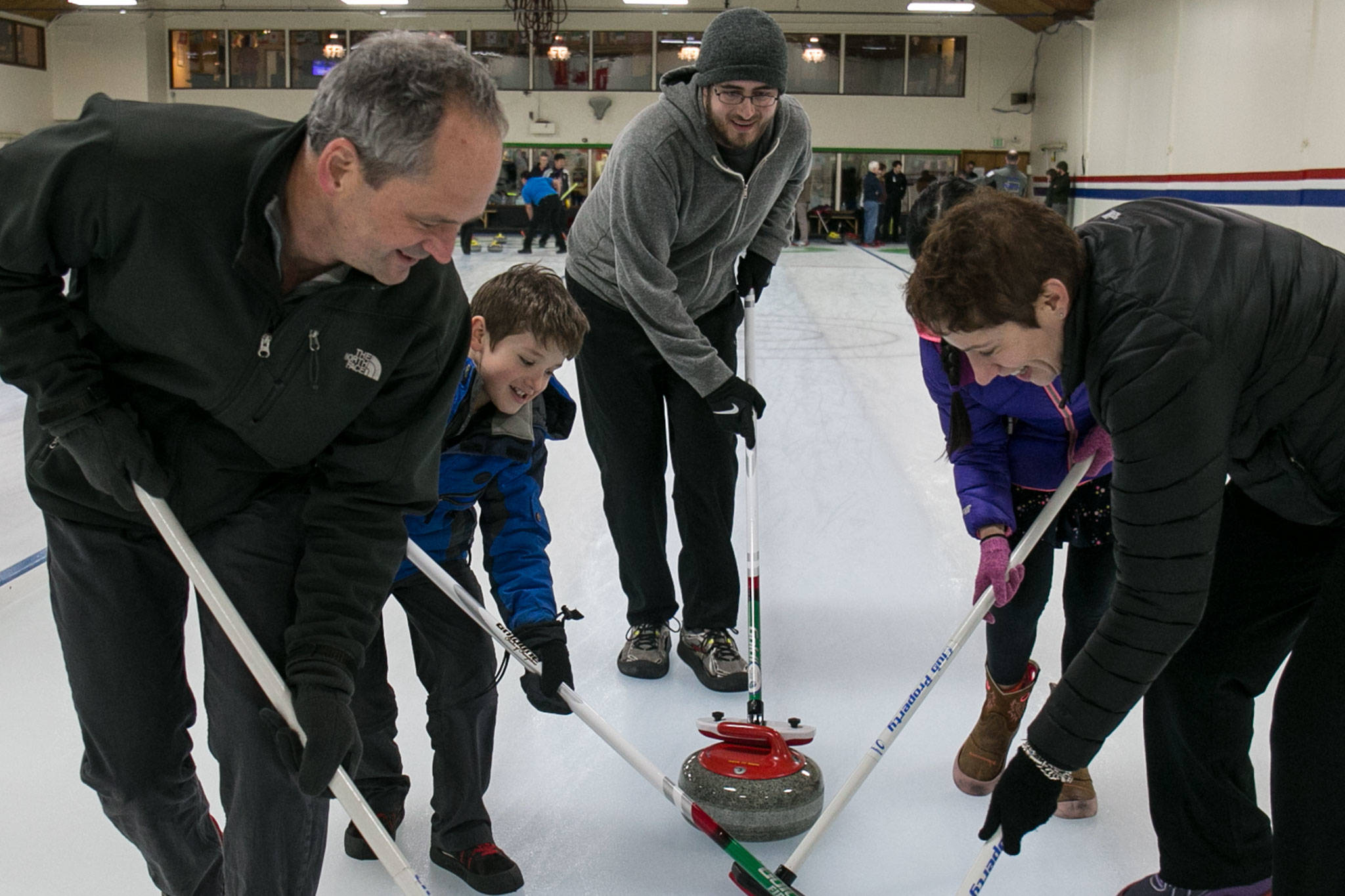Every four years, curlers inevitably turn into the darlings of February. The game of throwing granite stones on a sheet of ice is unlike any other sport in the Winter Games, and it attracts a lot of casual interest as fans root for the Olympics’ every man.
Those funny pants, strong handshakes and steely glares. All that eager sweeping.
With the 2018 Winter Games wrapping up, Seattle’s Granite Curling Club is anticipating an influx of the curling curious at its annual open houses. It happens every four years. As folks watch the Games, they see curling as that rare mix of exotic yet approachable. People think: Hey, that’s strange, but I think I can do that.
That’s what Dani Thibodeaux, a volunteer at the club, thought. Having grown up in Minnesota, a curling hotbed, she didn’t pick up the game until she was well past middle age.
“How many sports can you pick up after you turn 50?” Thibodeaux said, laughing.
Tom Fitzgerald, who coordinates the club’s open houses and volunteers behind the upstairs bar at the club, slings “aiming fuel,” and chats amiably with his fellow curlers. He moved to the Northwest from New York 25 years ago and picked up the sport after signing up for an open house.
“It’s mostly the camaraderie that I love,” Fitzgerald said. “You walk in here and you have 400 friends.”
Open houses act as a gateway for those interested in the game. Curling veterans take groups of eight, spread them out on the traditional long sheet of ice and start breaking down the basics. Place your dominant foot in the hack, or a small rubber backstop, push off and get your knee under you as your other foot glides over the ice under a swatch of teflon. It’s like doing lunges on a bed of ball bearings.
Got that down? Now do it with a 44-pound granite stone in your hand. Then let it go, always keeping in mind it’s slick and the surface is very hard.
Ken Rossman, who surprised his wife, Sarita Viramontez, with a pair of tickets to a recent open house, learned that the hard way. He fell and hurt his shoulder on one of his first lunges out of the hack and spent the rest of the class using the stick delivery method that wheelchair competitors use.
Rossman and Viramontez wanted to try curling since watching the sport while attending the Vancouver Games eight years ago. That was a common theme at the recent open house. Jim and Peggy Burns signed up after a visit to New Brunswick.
“While they were there, curling was on every TV all day long,” said the Burns’ daughter, Eileen, of Seattle. “They figured they had to find out about it.”
A pair of families, the Kerwins and Normans, signed up together to expand their horizons. The informal open house format is friendly for kids of all ages. Kurt and Jelena Norman and their children Lars, 7, and Sole, 11, and Bill and Kim Kerwin, and their kids Quinn, 14, and Ruby, 11, all picked up the game quickly, laughing and joking with one another throughout the two hours. Sweeping, a major part of curling, was even done with smiles on the kids’ faces.
The second half of the introductory class is game time as the groups of eight split up into teams of four. The teams designate the order of throwers and a skip, or team captain who stands on the opposite side of the ice directing traffic. But before anyone throws a stone, everyone shakes hands and wishes each other, “Good curling.”
“Curling is really a game of etiquette,” said Johnny Maino, one of the volunteer teachers.
“Sportsmanship is a big deal here,” added Zach Simon, a fellow teacher. “Everyone is always encouraging and that’s a big part of the game.”
Johnny Maino, who grew up in Michigan, credits the game’s welcoming and familial atmosphere to its Canadian and Midwestern roots. But while curling is on the wane in Canada, it’s growing in popularity in the U.S. Once upon a time, the Granite Curling Club was the only curling club on the West Coast. Now they’re popping up in Oakland, Denver, Arizona and Portland.
After a couple of games, the curling newbies are encouraged to retire to the upstairs bar. In the adjoining room, a group of league players enjoy a potluck meal after a friendly game. In the bar, volunteers Simon, Maino and Aaron Thompson chat with newcomers Siobhan O’Toole and Ryan Porter, while Fitzgerald pours more aiming fuel. The veterans regale the first-timers with stories about the history of the game, how to join a novice league and brushes with Olympians like American curler John Shuster, who just helped the U.S. knock off Canada in the 2018 Olympics.
“Curling is above all a social experience,” said Thompson, who has been curling for five years. “People come after work, curl a game and then share a meal. It’s all part of the game.”
O’Toole, who grew up in Wisconsin, Minnesota and Michigan’s Upper Peninsula, finds out she went to the same school as Maino: Michigan Tech. She never tried curling while living in the Midwest, but the evening of curling in Seattle had her feeling nostalgic.
“I feel like we were transported to the Midwest for a night,” O’Toole said.
Want to try curling?
With the Olympics coming to an end, Seattle’s Granite Curling Club has limited openings at just three of its annual open houses: March 25 and 31 and April 2. Registration is $25 per person or $60 per family. The classes fill up quick, so hurry. Spring leagues start April 9. A $50 spring membership includes chance to attend the club’s Learn to Curl class. For more information, visit www.curlingseattle.org.
Talk to us
> Give us your news tips.
> Send us a letter to the editor.
> More Herald contact information.



























